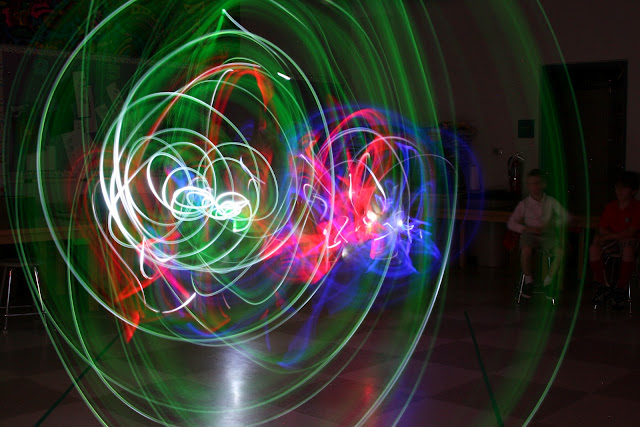 So, the second week of light graffiti is a less experimental and more deliberate. Our goal the second week is to create recognizable pictures. Students work in groups to create simple compositions based on a slip of paper they pull from a bucket -- it is harder than it seems.
So, the second week of light graffiti is a less experimental and more deliberate. Our goal the second week is to create recognizable pictures. Students work in groups to create simple compositions based on a slip of paper they pull from a bucket -- it is harder than it seems.So I do an example with a few volunteers from the class so that kids understand how it works. I first ask my volunteers to each pull a strip of paper from a bucket. In the bucket there are strips with words and a simple picture: grass, house, flower, tree, cloud, sun, and stars. When we each have a strip of paper telling us what we are going to draw - we combine our images onto a piece of paper to make a picture. I let each person draw their element on the paper and point out that no one is being bossy and telling people where to put each piece.
 |
| 1st Try |
 |
| 2nd Try |
I help set up our picture by asking the class to help us figure out where to stand. I ask them "Where should the grass be - front, back or middle?" - Most of the time they all agree with the front, but some classes need a little help figuring it out. "Should the grass be drawn up in the air by my belly button?" - No. "Where should the grass be?" -- On the floor. "Okay, so now where should the flower go?" - Behind the grass. "Where should the flower grow from?" - The grass/floor". This process goes on till all our elements are in place. Next, we take the picture. When the picture is displayed on the projector we take a look and make adjustments to where we are standing, how fast we need to draw, covering our light when we are done, or perhaps getting a new light. We then do a 2nd picture to try and improve. Often times the 2nd picture is WAY better - though not always. Below is a video of students doing their 2nd picture.
Next, the students break up into groups of about 5, pull their strips, draw their picture, hand in their picture and wait for their turn. We go through the groups one at a time - making sure each group gets at least 2 pictures from the camera.
Most groups did a great job and exclaimed how much harder it was than they thought it would be.





